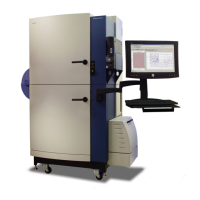FLIPR
®
Tetra High Throughput Cellular Screening System User Guide
0112-0109 H 181
Loading the Cells Using Loading Buffer
To load the cells:
1. Remove the cell plates from the incubator or centrifuge. Do not
remove the supernatant. Add Loading Buffer to each well (100
μL per well for 96-well plates,
25 μL for 384-well or 2 μL for 1536-well plates).
2. Incubate the cell plates for 30 minutes at 37 °C.
CAUTION! Do NOT wash the cells after dye loading.
Running the FLIPR
Membrane Potential Assay
Before incubation, ensure that the FLIPR
®
Tetra System is equipped
with the 510–545 nm LED module and 565–625 nm emission filter. See
LED module and emission filter installation instructions in Chapter 5,
“Exchanging Hardware” for a picture diagram can be faxed to you by
contacting Technical Support at +1-800-653-5577.
1. Choose the 510–545/565–625 excitation/emission wavelengths
respectively from the Settings process in ScreenWorks
Software. After incubation transfer the plates directly to FLIPR
®
Tetra System and begin the Membrane Potential assay.
The Membrane Potential assay may be performed at room
temperature up to physiological temperature.
2. Place the filter holder in its correct position in the FLIPR
®
Tetra
System. For a signal test, a starting average count of
1,500-2,500 RLU is recommended.
Note: Although Molecular Devices does not recommend
washing cells before dye loading, growth medium and serum
factors can be washed away before adding the Loading Buffer,
provided residual volumes after the wash step are as described.
Alternatively, cells can be grown in serum-free conditions.
Note: In some cases, incubation at room temperature may
improve results.

